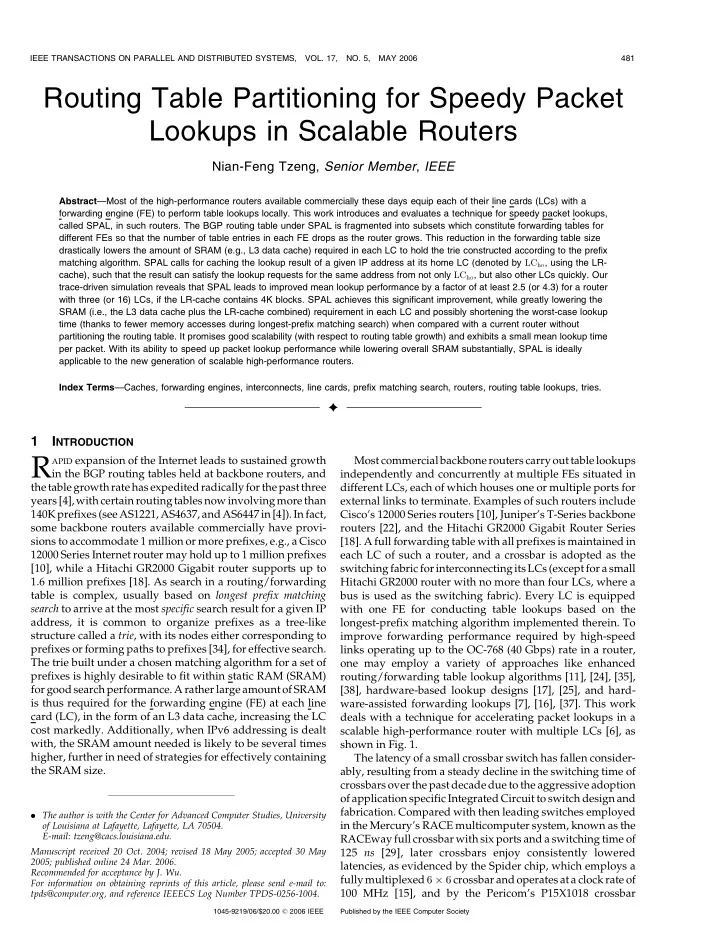

IEEE TRANSACTIONS ON PARALLEL AND DISTRIBUTED SYSTEMS, VOL. 17, NO. 5, MAY 2006 481 Routing Table Partitioning for Speedy Packet Lookups in Scalable Routers Nian-Feng Tzeng, Senior Member , IEEE Abstract —Most of the high-performance routers available commercially these days equip each of their line cards (LCs) with a forwarding engine (FE) to perform table lookups locally. This work introduces and evaluates a technique for speedy packet lookups, called SPAL, in such routers. The BGP routing table under SPAL is fragmented into subsets which constitute forwarding tables for different FEs so that the number of table entries in each FE drops as the router grows. This reduction in the forwarding table size drastically lowers the amount of SRAM (e.g., L3 data cache) required in each LC to hold the trie constructed according to the prefix matching algorithm. SPAL calls for caching the lookup result of a given IP address at its home LC (denoted by LC ho , using the LR- cache), such that the result can satisfy the lookup requests for the same address from not only LC ho , but also other LCs quickly. Our trace-driven simulation reveals that SPAL leads to improved mean lookup performance by a factor of at least 2.5 (or 4.3) for a router with three (or 16) LCs, if the LR-cache contains 4K blocks. SPAL achieves this significant improvement, while greatly lowering the SRAM (i.e., the L3 data cache plus the LR-cache combined) requirement in each LC and possibly shortening the worst-case lookup time (thanks to fewer memory accesses during longest-prefix matching search) when compared with a current router without partitioning the routing table. It promises good scalability (with respect to routing table growth) and exhibits a small mean lookup time per packet. With its ability to speed up packet lookup performance while lowering overall SRAM substantially, SPAL is ideally applicable to the new generation of scalable high-performance routers. Index Terms —Caches, forwarding engines, interconnects, line cards, prefix matching search, routers, routing table lookups, tries. � 1 I NTRODUCTION R APID expansion of the Internet leads to sustained growth Most commercialbackbonerouterscarryouttable lookups in the BGP routing tables held at backbone routers, and independently and concurrently at multiple FEs situated in the table growth ratehas expedited radically for thepast three different LCs, each of which houses one or multiple ports for years [4],with certain routing tablesnow involving morethan external links to terminate. Examples of such routers include 140K prefixes (see AS1221, AS4637, and AS6447 in [4]). In fact, Cisco’s 12000 Series routers [10], Juniper’s T-Series backbone some backbone routers available commercially have provi- routers [22], and the Hitachi GR2000 Gigabit Router Series sions to accommodate 1 million or more prefixes, e.g., a Cisco [18]. A full forwarding table with all prefixes is maintained in 12000 Series Internet router may hold up to 1 million prefixes each LC of such a router, and a crossbar is adopted as the [10], while a Hitachi GR2000 Gigabit router supports up to switching fabric for interconnecting its LCs(except for asmall 1.6 million prefixes [18]. As search in a routing/forwarding Hitachi GR2000 router with no more than four LCs, where a table is complex, usually based on longest prefix matching bus is used as the switching fabric). Every LC is equipped search to arrive at the most specific search result for a given IP with one FE for conducting table lookups based on the address, it is common to organize prefixes as a tree-like longest-prefix matching algorithm implemented therein. To structure called a trie , with its nodes either corresponding to improve forwarding performance required by high-speed prefixes or forming paths to prefixes [34], for effective search. links operating up to the OC-768 (40 Gbps) rate in a router, The trie built under a chosen matching algorithm for a set of one may employ a variety of approaches like enhanced prefixes is highly desirable to fit within static RAM (SRAM) routing/forwarding table lookup algorithms [11], [24], [35], for good search performance. A rather large amount of SRAM [38], hardware-based lookup designs [17], [25], and hard- is thus required for the forwarding engine (FE) at each line ware-assisted forwarding lookups [7], [16], [37]. This work card (LC), in the form of an L3 data cache, increasing the LC deals with a technique for accelerating packet lookups in a cost markedly. Additionally, when IPv6 addressing is dealt scalable high-performance router with multiple LCs [6], as with, the SRAM amount needed is likely to be several times shown in Fig. 1. higher, further in need of strategies for effectively containing The latency of a small crossbar switch has fallen consider- the SRAM size. ably, resulting from a steady decline in the switching time of crossbars over the past decade due to the aggressive adoption of application specific Integrated Circuit to switch design and fabrication. Compared with then leading switches employed . The author is with the Center for Advanced Computer Studies, University in the Mercury’s RACE multicomputer system, known as the of Louisiana at Lafayette, Lafayette, LA 70504. E-mail: tzeng@cacs.louisiana.edu. RACEway full crossbar with six ports and a switching time of Manuscript received 20 Oct. 2004; revised 18 May 2005; accepted 30 May 125 ns [29], later crossbars enjoy consistently lowered 2005; published online 24 Mar. 2006. latencies, as evidenced by the Spider chip, which employs a Recommended for acceptance by J. Wu. fully multiplexed 6 � 6 crossbar and operates at a clock rate of For information on obtaining reprints of this article, please send e-mail to: 100 MHz [15], and by the Pericom’s P15X1018 crossbar tpds@computer.org, and reference IEEECS Log Number TPDS-0256-1004. 1045-9219/06/$20.00 � 2006 IEEE Published by the IEEE Computer Society
Recommend
More recommend